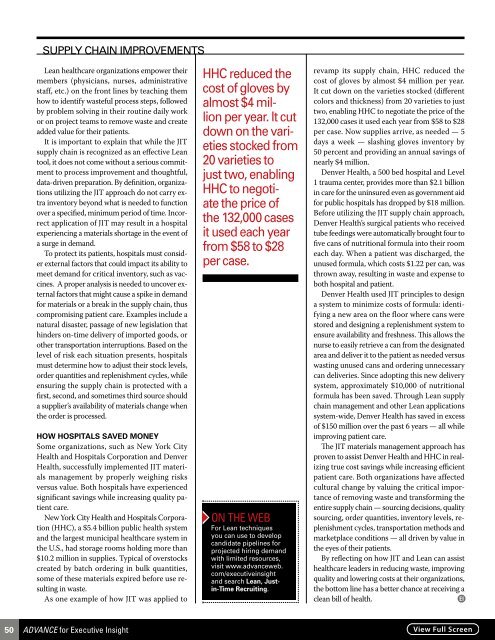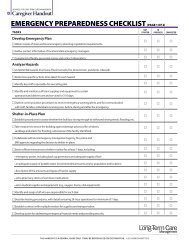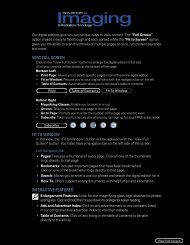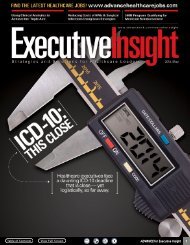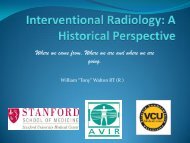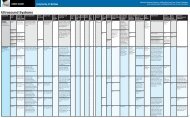1 ADVANCE for Executive Insight
1 ADVANCE for Executive Insight
1 ADVANCE for Executive Insight
- No tags were found...
Create successful ePaper yourself
Turn your PDF publications into a flip-book with our unique Google optimized e-Paper software.
supply chain improvements<br />
Lean healthcare organizations empower their<br />
members (physicians, nurses, administrative<br />
staff, etc.) on the front lines by teaching them<br />
how to identify wasteful process steps, followed<br />
by problem solving in their routine daily work<br />
or on project teams to remove waste and create<br />
added value <strong>for</strong> their patients.<br />
It is important to explain that while the JIT<br />
supply chain is recognized as an effective Lean<br />
tool, it does not come without a serious commitment<br />
to process improvement and thoughtful,<br />
data-driven preparation. By definition, organizations<br />
utilizing the JIT approach do not carry extra<br />
inventory beyond what is needed to function<br />
over a specified, minimum period of time. Incorrect<br />
application of JIT may result in a hospital<br />
experiencing a materials shortage in the event of<br />
a surge in demand.<br />
To protect its patients, hospitals must consider<br />
external factors that could impact its ability to<br />
meet demand <strong>for</strong> critical inventory, such as vaccines.<br />
A proper analysis is needed to uncover external<br />
factors that might cause a spike in demand<br />
<strong>for</strong> materials or a break in the supply chain, thus<br />
compromising patient care. Examples include a<br />
natural disaster, passage of new legislation that<br />
hinders on-time delivery of imported goods, or<br />
other transportation interruptions. Based on the<br />
level of risk each situation presents, hospitals<br />
must determine how to adjust their stock levels,<br />
order quantities and replenishment cycles, while<br />
ensuring the supply chain is protected with a<br />
first, second, and sometimes third source should<br />
a supplier’s availability of materials change when<br />
the order is processed.<br />
How Hospitals Saved Money<br />
Some organizations, such as New York City<br />
Health and Hospitals Corporation and Denver<br />
Health, successfully implemented JIT materials<br />
management by properly weighing risks<br />
versus value. Both hospitals have experienced<br />
significant savings while increasing quality patient<br />
care.<br />
New York City Health and Hospitals Corporation<br />
(HHC), a $5.4 billion public health system<br />
and the largest municipal healthcare system in<br />
the U.S., had storage rooms holding more than<br />
$10.2 million in supplies. Typical of overstocks<br />
created by batch ordering in bulk quantities,<br />
some of these materials expired be<strong>for</strong>e use resulting<br />
in waste.<br />
As one example of how JIT was applied to<br />
HHC reduced the<br />
cost of gloves by<br />
almost $4 million<br />
per year. It cut<br />
down on the varieties<br />
stocked from<br />
20 varieties to<br />
just two, enabling<br />
HHC to negotiate<br />
the price of<br />
the 132,000 cases<br />
it used each year<br />
from $58 to $28<br />
per case.<br />
revamp its supply chain, HHC reduced the<br />
cost of gloves by almost $4 million per year.<br />
It cut down on the varieties stocked (different<br />
colors and thickness) from 20 varieties to just<br />
two, enabling HHC to negotiate the price of the<br />
132,000 cases it used each year from $58 to $28<br />
per case. Now supplies arrive, as needed — 5<br />
days a week — slashing gloves inventory by<br />
50 percent and providing an annual savings of<br />
nearly $4 million.<br />
Denver Health, a 500 bed hospital and Level<br />
1 trauma center, provides more than $2.1 billion<br />
in care <strong>for</strong> the uninsured even as government aid<br />
<strong>for</strong> public hospitals has dropped by $18 million.<br />
Be<strong>for</strong>e utilizing the JIT supply chain approach,<br />
Denver Health’s surgical patients who received<br />
tube feedings were automatically brought four to<br />
five cans of nutritional <strong>for</strong>mula into their room<br />
each day. When a patient was discharged, the<br />
unused <strong>for</strong>mula, which costs $1.22 per can, was<br />
thrown away, resulting in waste and expense to<br />
both hospital and patient.<br />
Denver Health used JIT principles to design<br />
a system to minimize costs of <strong>for</strong>mula: identifying<br />
a new area on the floor where cans were<br />
stored and designing a replenishment system to<br />
ensure availability and freshness. This allows the<br />
nurse to easily retrieve a can from the designated<br />
area and deliver it to the patient as needed versus<br />
wasting unused cans and ordering unnecessary<br />
can deliveries. Since adopting this new delivery<br />
system, approximately $10,000 of nutritional<br />
<strong>for</strong>mula has been saved. Through Lean supply<br />
chain management and other Lean applications<br />
system-wide, Denver Health has saved in excess<br />
of $150 million over the past 6 years — all while<br />
improving patient care.<br />
The JIT materials management approach has<br />
proven to assist Denver Health and HHC in realizing<br />
true cost savings while increasing efficient<br />
patient care. Both organizations have affected<br />
cultural change by valuing the critical importance<br />
of removing waste and trans<strong>for</strong>ming the<br />
entire supply chain — sourcing decisions, quality<br />
sourcing, order quantities, inventory levels, replenishment<br />
cycles, transportation methods and<br />
marketplace conditions — all driven by value in<br />
the eyes of their patients.<br />
By reflecting on how JIT and Lean can assist<br />
healthcare leaders in reducing waste, improving<br />
quality and lowering costs at their organizations,<br />
the bottom line has a better chance at receiving a<br />
clean bill of health.<br />
50 <strong>ADVANCE</strong> <strong>for</strong> <strong>Executive</strong> <strong>Insight</strong>


